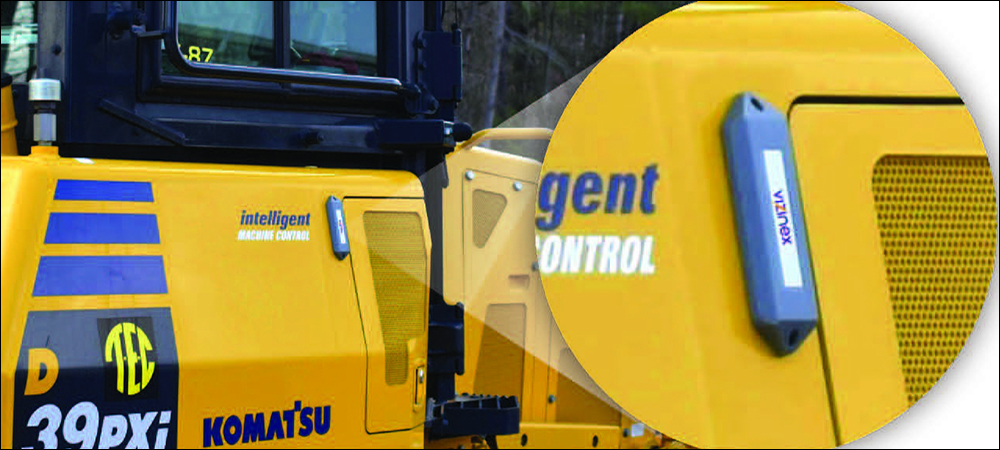Vizinex RFID, located in Bethlehem, Penn., has released what it calls its highest-performing XLR tag, replacing a previous product that was six years old. The new tag is designed to provide companies with passive UHF RFID functionality that comes close to the read distance of battery-assisted or active tags, Vizinex reports, while the tag is small and relatively low in cost. The new XLR tag has a read range of more than 100 feet on metal surfaces, according to Ken Horton, Vizinex RFID’s cofounder and CEO. Since it does not require a battery to achieve that read distance, he says, the tag requires no maintenance and is long-lived in industrial environments.
With the latest version of the XLR, Horton reports, companies will be able to establish zone-based location management with less reader infrastructure than is traditionally required because of the read range. That means better coverage of a storage yard or warehouse, for instance. For those already using UHF RFID readers, such as portals, the tags can still offer better read rates, the company notes. What’s more, they are smaller and lower in cost than the previous version.

The tag contains Impinj‘s M750 chip, which enables a wide broadband frequency and other features. Vizinex is using less material in its latest tag, which includes replacing the stainless steel that had previously been utilized to ensure durability with rigidized plastic. The new materials enable a long read range on metal or other substances, while reducing the size of the tag. With molded plastic as part of the structure, the tag can now be sold at a reduced cost, the company reports. The tag measures 5.28 inches by 1.7 inches by 0.5 inch, Horton says, describing it as the smallest industrial passive tag in its class.
The company envisions military agencies and other users tracking assets; construction companies managing tools, materials and vehicles on construction sites; and other businesses accomplishing asset management in warehouses or yards. Horton says the XLR was originally designed for such use cases as military asset tracking, yard or fleet management, and cargo, container and pallet tracking. The earlier version of the XLR was released around seven years ago, he says, and was made using a building process that was relatively expensive. The newest version reduces that cost by about 25 percent, the company claims.

Ken Horton
According to Horton, the long-range XLR had been a staple product for more than half a decade, but Vizinex sought to upgrade the tag. In addition to increasing its read range, the firm hoped to provide a single product that could operate across the worldwide UHF frequency spectrum, from 856 to 925 MHz. “So we have improved bandwidth performance,” he states.
The M750 chip comes with 96 bits of Electronic Product Code (EPC) memory and 32 bits of user memory, as well as enhanced autotuning, and it enables a wide frequency response and a smaller size. For XLR users seeking cost savings or smaller tags, Horton says, “It was a win-win-win. We have a tag that is significantly less expensive and smaller [than similar UHF RFID tags], with a better read range.” With the next-generation XLR, he adds, “We have leapfrogged the competition.”
The tag is poised to provide several benefits, Horton reports. For companies already using UHF RFID technology in outdoor or other harsh environments with portal readers, he says, the long range may not be necessary, but the tag’s sensitivity could increase read reliability. That means users may gain a higher rate of tag capture as tagged goods pass through dock doors or gates at the entrance or exit to a yard.
In some cases, however, companies might need more location information than simply identifying when goods pass through a portal. In such a scenario, Horton says, the long range provides visibility into a yard or storage area. Traditionally, that has required a dense network of RFID readers to capture tags at a distance of 30 to 90 feet. The new XLR version does not require as many readers to capture tag ID numbers, he explains.
Horton predicts the new tag will help to propel a movement of passive RFID toward the kind of long-range tag reads expected from battery-assisted passive or active tags. “One of the criticisms of passive RFID,” he explains, “is that there is not enough range, so [companies] tend to add a battery.” But the use of batteries requires a larger tag, which costs more. It also requires maintenance since batteries need to be periodically replaced. “As the read range of passive [RFID] expands, it allows people to work with a much less expensive tag” to enable reliable reads of objects ranging from tools to vehicles parked or stored in wide areas.
Businesses that may adopt the newest XLR version, Horton says, include those that sell or employ containers or other reusable transport items. The application of RFID to such assets can be challenging due to the impacts to which they could be exposed. The smaller form factor provides a solution to this problem, he explains, since users could apply the tag in a position where it is protected, such as between ribs or behind a handle. The tag also works well for waste management, he notes, since it could be applied to a dumpster or trash bin and then be read from a relative distance by trucks or other vehicles.
Vizinex’s tags are manufactured at the company’s Pennsylvania site, Horton says, so they don’t require the shipping costs or time that would be needed if users purchased tags made in Asia. The XLR tags work best when mounted on metal, the company reports, but they offer a consistent read range on most other surfaces as well. The tags can withstand vibration, weather elements, road salt, harsh cleaning chemistries and other environmental challenges for extended periods. Commercially available now in large volume, they offer a temperature tolerance of -58 to +212 degrees Fahrenheit (-50 to +100 degrees Celsius) and are IP68-rated for ruggedization.

